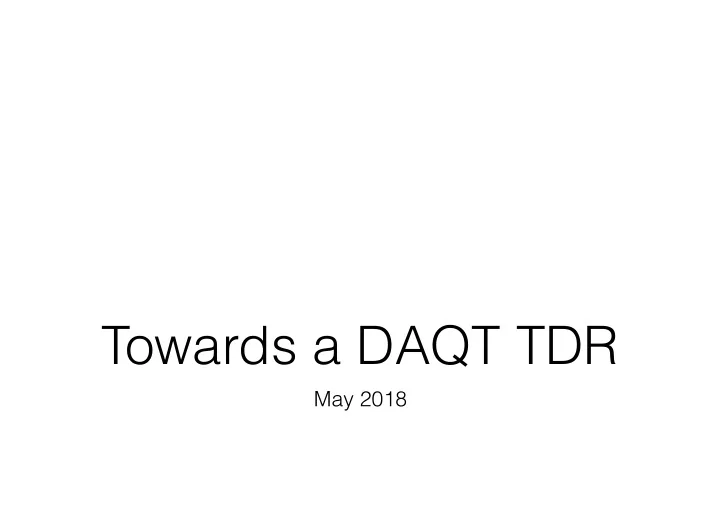

Towards a DAQT TDR May 2018
Contents of Phase 1 TDR • Introduction : physics objectives, detector configuration • Cross sections, luminosities, detector performance (tracking, EMC, PID …) • Requirements ( event rates, event size, pile-up situation, storage capacity, event filtering capabilities, partitioning of DAQ, running modes …) • System architecture • Building blocks ( time synchronisation (SODAnet), data concentrators, data transport, FPGA based Compute Nodes, CPU/GPU farm, …) • Data format, interfaces and data flow • Event filter: partitioning and performance of algorithms (L1, L2), … • Run control system, error detection and recovery, Data Quality Monitoring (DQM) • Performance simulations and measurements with prototype systems • Manpower, schedule and cost 2
Readout Approach for PANDA The PANDA readout consist of: ● Intelligent self-triggered front-end : autonomous hit detection and data pre- processing (e.g. based on 100101101 S ampling A nalogue to D igital C onverter) ● a very precise time distribution system (SODANET) : single clock-source for PANDA (event correlation) ● time-sorting and processing data in real-time : processing in FPGA ( F ield- P rogrammable G ate A rray)
DAQ Architecture FrontEnd Electronics • Assumptions for Phase 1 20 GB/s • up to 10 6 events/s - 20 GB/s Data Concentrators • separate runs for physics with “large” vs. “small” cross sections 20 GB/s • negligible overlap between events Event(Burst)- Building Network (needs to be checked by 20 GB/s simulations) FPGA based event filtering • Final reduction factor for small cross section physics: 100 < 2GB/s • Reduction by FPGA layer: 10 CPU/GPU based event filtering • Large cross section physics <0.2 GB/s requires reduced luminosity due to storage limitations Storage 4
Definition of requirements, interfaces and protocols • Detector configuration, physics programme of Phase 1 needs to be defined Work in Progress • Cross sections, background situation • Event rate, event size and required rejection factors, acceptable efficiency loss Next steps • Protocols, interfaces and network topology specifications: SODANET finished Burst-building network: ● Define protocols (data, control) ● Define interfaces for the standard data-processing IP-cores for the burst-building network: ● Acquire requests from all sub-systems information on required data processing (e.g. pre-clustering, at least time-ordered merging To be done of streams) Event building: ● Define protocol between the burst-building network and compute nodes (where final particle reconstruction will take place) ● Define network topology (static, dynamic with load-based distribution) ● Define interface to the PC farm Two options: 10 Gb Ethernet or Aurora links to PCIe card PC farm, final event filtering 11 5
Data format for transport between FEE/Data Concentrators and CN layer • Proposal: define universal packet format, independent of detector subsystem • Advantage: we can use the same set of IP cores to handle data streams independent of detector and DAQ layer • Data is streamed and organised in packets • Push architecture, but with support for back pressure • Data Origin Definitions: • “detector”: Panda Subsystem ID (EMC, STT, MVD etc.) • reserve one byte for unique detector definition • “module” : section ID of a detector (EMC Forward endcap, STT stereo layer, MVD pixels etc.) • reserve one byte for unique module definition • “location”: unique identifier for the geographical location of a hit within a module (could be STT wire number, MVD pixel ID etc. • reserve 4 bytes (need addressing space for MVD) • 6
Universal Packet Format (UPF) • Each packet contains a packet header with the following information (distributed in part by SODANET to FEE and/or set by slow control in FEE for local runs): • ID for “experiment” number (should be unique over the lifetime of Panda) (2 Bytes ?) (set by run control) • Run number (is reset at the start of a new experiment) 2 Bytes (set by run control) • Run type (physics, calibration, test/debug, local run, etc.) 1 Byte (set by run control) • Event selection identifier or has code pointing to data base(4 bytes ?) • Superburst ID: 4 Byte (to be distributed by SODANET) (use also as last packet flag) • Payload size (in bytes): 3 Bytes, payload item size in bytes (1 byte) (detector specific) • Payload header : Number of items in payload • Payload items: • Time stamp • Data Origin • Data value(s) (detector-specific) • Payload trailer: repeat payload size, add checksum (CRC) • Packet trailer • repeat payload size (for redundancy, debugging and recovery • CRC (packet checksum) 7
Data format for transport between FEE/Data Concentrators and CN layer Packet Header Payload Header Payload Item 1 Payload Item N Payload Trailer Packet Trailer 8
Comments • There is some redundancy in the data format • Important for development and integration phase • In a later stage, we can think about removing some redundancy for a more compact data format • There is some freedom for detector - specific aspects in the payload • payload item size and number of data values per item can vary • data origin definitions RE are flexible (could be “single EMC crystal” or EMC cluster) 9
Data Format: next steps: • Agree on the details of the proposed data format • needs discussion with FEE developers • Is the allocated byte size for the individual headers adequate (in particular, for MVD) ? • How large is the overhead (# bytes for headers /# data bytes) • Look into simulated data, right after digitisation 10
Open questions • Panda configuration for DAY 1 physics • Depending on the configuration, what is “first physics" • event filtering simulations required 11
Recommend
More recommend